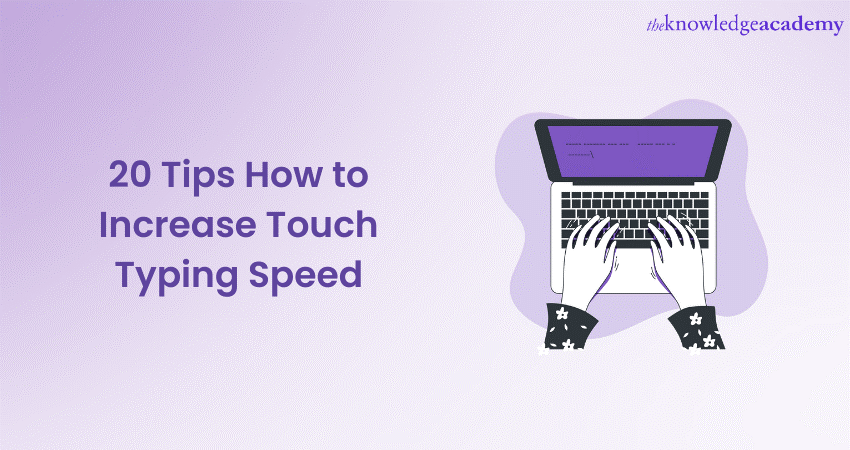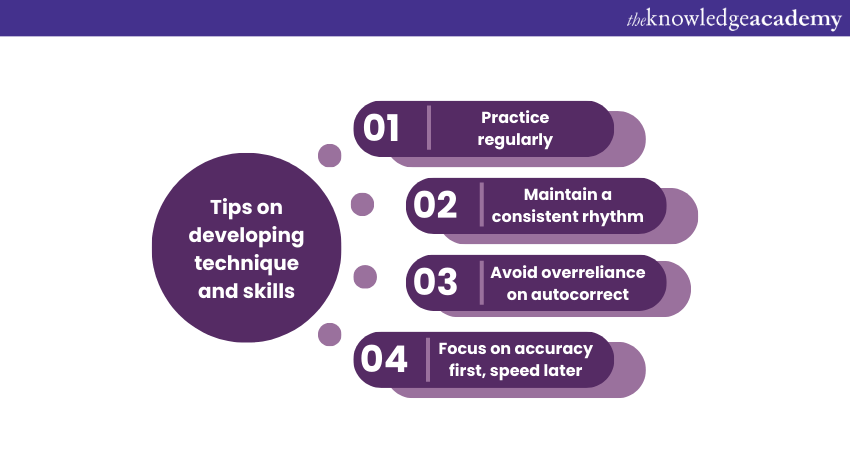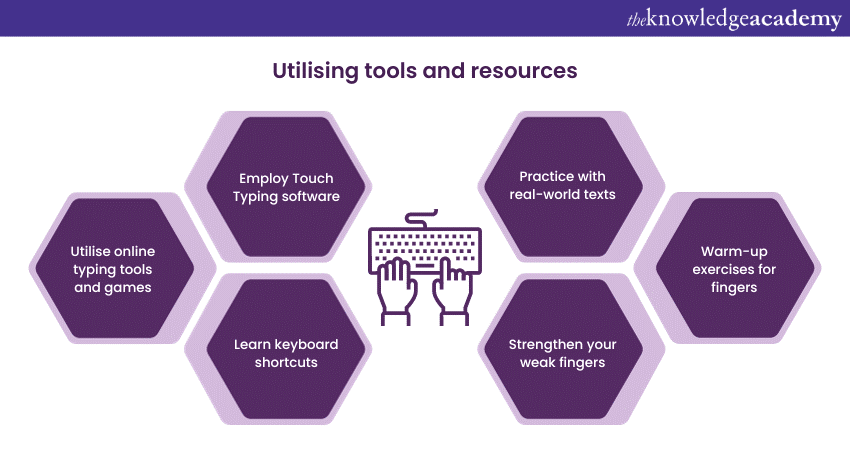We may not have the course you’re looking for. If you enquire or give us a call on +39 800580270 and speak to our training experts, we may still be able to help with your training requirements.
Training Outcomes Within Your Budget!
We ensure quality, budget-alignment, and timely delivery by our expert instructors.

If you want to excel in your typing skills and are willing to know How to Increase Touch Typing Speed? Well, you are at the right place. Touch Typing is a typing method where a typist uses all ten fingers to type on a keyboard without looking at the keys. If you It relies on muscle memory and knowledge of where each key is located on the keyboard.
The typist's fingers are positioned on the home row, a set of keys in the middle row of the keyboard, and from there, they reach for keys as needed, always returning to the home row. In this blog, you will learn 20 tips on How to Increase Touch Typing Speed and master the skill of Touch Typing. Read more to learn!
Table of Contents
1) Tips to establish a strong foundation
2) Tips on developing technique and skills
3) Utilising tools and resources
4) Tips to monitoring progress and staying motivated
5) Conclusion
Tips to establish a strong foundation
Establishing a strong foundation in Touch Typing lays down the groundwork to master the skill and it ensures stability and longevity in your typing skills. Some of the important foundational skills are as follows:
Mastering the home row
Mastering the home row is the cornerstone of Touch Typing. It involves training your fingers to rest on specific keys, namely ASDF for the left hand and JKL; for the right hand. This position serves as a reference point, allowing you to reach all other keys efficiently. By developing muscle memory for the home row, you'll be able to type without constantly glancing at the keyboard, leading to increased speed and accuracy.
Unlock your typing potential with our Touch Typing Training - Register now and master touch typing for improved productivity!
Familiarise yourself with keyboard layout
Understanding the layout of the keyboard is crucial for Touch Typing proficiency. Take time to learn the position of each key and the function of special keys like Shift, Enter, and Backspace. This familiarity will enable you to locate keys without hesitation, contributing to a smoother typing experience.
Minimise looking at the keyboard
Resist the urge to constantly look at the keyboard while typing. Trust your muscle memory and the knowledge of the key positions. Initially, it may feel challenging, but over time, this practice will significantly improve your typing speed and accuracy.
Use proper posture and ergonomics
Maintaining the right posture and ergonomic setup is essential for long-term typing comfort. Sit with your feet flat on the ground, back straight, and arms at a comfortable angle. Your keyboard should be at elbow height, allowing for relaxed and natural typing movements. Additionally, invest in an ergonomic keyboard and chair to prevent strain and discomfort during extended typing sessions.
Tips on developing technique and skills
These tips focus on refining your typing abilities, allowing you to type effortlessly without constantly looking at the keyboard. By practicing these techniques regularly, you'll notice a significant improvement in your typing speed and precision.

Practice regularly
Regular practice is the bedrock of Touch-Typing proficiency. Dedicate consistent time to typing exercises, gradually increasing complexity. This repetition builds muscle memory, allowing your fingers to intuitively find the keys. Start with simple sentences and eventually progress to more challenging texts. Regular practice not only enhances your typing speed but also reinforces accuracy and confidence.
Maintain a consistent rhythm
Developing a steady typing rhythm is key to efficient Touch Typing. Find a comfortable pace that allows you to strike keys smoothly without rushing or hesitating. Avoid erratic typing patterns, as they can lead to errors and fatigue. A consistent rhythm ensures a flow of thought from mind to screen, significantly boosting productivity.
Avoid overreliance on autocorrect
While autocorrect can be a helpful tool, relying on it too heavily hinders your typing progress. It's important to train your fingers to hit the correct keys without immediate correction. This builds accuracy and reduces dependency on autocorrect. Over time, you'll find yourself making fewer mistakes and producing higher-quality work.
Focus on accuracy first, speed later
Accuracy should always take precedence over speed when honing Touch Typing skills. Concentrate on hitting the right keys, even if it means typing at a slower pace initially. As your accuracy improves, gradually increase your speed. Striking a balance between accuracy and speed ensures that you produce error-free content efficiently.
Utilising tools and resources
When it comes to learning Touch Typing, having the right tools and resources with you can make a lot of difference. These resources are like helpful companions on your journey to becoming a proficient typist. The following are the tips that will help you leverage various tools:

Utilise online typing tools and games
Online typing tools and games provide an engaging and interactive way to enhance Touch Typing skills. Platforms like Nitro Type, and 10FastFingers offer a variety of exercises, games, and typing tests to help improve speed and accuracy.
These tools often track progress and provide performance metrics, allowing you to monitor your development over time. By incorporating these resources into your practice routine, you can make significant strides in your touch-typing proficiency.
Employ Touch Typing software
Dedicated Touch-Typing software programs offer structured lessons and exercises to systematically improve typing skills. Programs like TypingClub, Keybr, and Ratatype guide users through a series of lessons, gradually introducing new keys and reinforcing muscle memory.
Additionally, they often include features like speed tests and accuracy assessments to track your progress. Using Touch Typing software provides a focused and guided approach to skill development.
Elevate your communication skills with our comprehensive Shorthand Training – Sign now to write faster and more efficiently!
Learn keyboard shortcuts
Keyboard shortcuts are invaluable for increasing typing efficiency. They allow you to perform tasks with minimal keystrokes, saving time and reducing the need for extensive typing. Common shortcuts like Ctrl+C (copy), Ctrl+V (paste), and Alt+Tab (switch between applications) can significantly streamline your workflow. By incorporating these shortcuts into your typing routine, you'll not only work faster but also become a more efficient computer user.
Practice with real-world texts
While exercises and drills are essential for skill-building, practicing with real-world texts adds a practical dimension to your Touch Typing proficiency. Transcribing articles, reports, or personal notes allows you to apply your skills in context. This helps reinforce your ability to type fluently and accurately in real-life scenarios, which is crucial for professional settings where typing speed and accuracy are paramount.
Warm-up exercises for fingers
Before diving into intensive typing sessions, it's essential to warm up your fingers to prevent strain or discomfort. Simple warm-up exercises like finger stretches, hand rotations, and light tapping on the keyboard can help loosen your fingers and improve blood flow. This prepares your hands for more extended periods of typing, ensuring a comfortable and productive experience.
Strengthen your weak fingers
Uneven finger strength can hinder typing speed and accuracy. Focus on exercises that target your weaker fingers, such as specific drills to improve the strength and dexterity of your pinky fingers. Strengthening all fingers ensures a balanced and efficient typing technique, allowing you to type effortlessly across the entire keyboard
Optimise your keyboard settings
Customising keyboard settings to your preference can greatly enhance your typing experience. Adjust parameters like key repeat rate, delay before key repeat, and keyboard sensitivity to suit your typing style. Additionally, consider enabling features like sticky keys or filter keys for accessibility. Optimising these settings ensures that your keyboard responds in a way that complements your typing technique which adds to a more comfortable and efficient typing experience.
Consider using a mechanical keyboard
A mechanical keyboard offers a tactile and responsive typing experience. The distinct feedback from each keypress can improve accuracy and provide a satisfying typing feel. Mechanical keyboards come in various types of switches, each with its unique characteristics. Research and choose a switch type that aligns with your typing preferences. While mechanical keyboards may require an adjustment period, many typists find them to be a valuable investment in their typing proficiency and overall comfort.
Tips to monitoring progress and staying motivated
Monitoring your progress and staying motivated are crucial aspects of improving your Touch-Typing skills. It's like keeping track of how fast and accurately you can type and finding ways to stay excited about getting better. Following are some of the tips to monitor your progress and stay motivated:
Monitor your progress and set goals
Regularly tracking your typing progress is essential for improvement. Use typing speed tests and accuracy assessments to measure your performance. Set realistic goals based on your current capabilities and gradually work towards increasing your speed and accuracy. Tracking your progress provides a tangible way to see your development over time, motivating you to continue refining your Touch-Typing skills.
Take breaks to avoid fatigue
Avoiding fatigue is crucial for sustainable Touch-Typing progress. Prolonged typing sessions can lead to strain and reduced accuracy. Take short, regular breaks to rest your fingers, stretch your hands, and relax your wrists. This not only prevents physical discomfort but also maintains mental focus. A well-rested typist is more likely to type accurately and efficiently.
Stay patient and persistent
Touch Typing proficiency is a skill that takes time to develop. It's important to be patient with yourself and understand that progress may be gradual. Don't be discouraged by initial challenges or slower typing speeds. Consistent practice and perseverance are key. Celebrate small achievements along the way and acknowledge your progress, no matter how incremental. With dedication and persistence, you'll see significant improvements in your Touch-Typing abilities.
Seek feedback and learn from mistakes
Feedback is a valuable tool for growth. Share your typing exercises or test results with peers, mentors, or online communities dedicated to Touch Typing. Listen to their input and learn from their observations. Additionally, review your own work and identify areas for improvement. Analyse any mistakes or inaccuracies and focus on correcting them in future practice sessions. Embracing feedback and learning from mistakes are integral aspects of honing your touch-typing skills effectively. Remember, every error is an opportunity to refine your technique and become a more proficient typist.
Conclusion
Mastering Touch Typing is a transformative skill with far-reaching benefits. It enhances efficiency, accuracy, and productivity in the digital realm. By diligently practicing the foundational techniques, utilising valuable resources, and maintaining a patient and persistent approach, individuals can significantly elevate their typing prowess. We hope that this blog will help you learn How to Increase Touch Typing Speed and become a proficient typist.
Ready to elevate your PA and Secretarial skills? Explore our comprehensive PA and Secretarial Training and embark on a journey towards excellence!
Frequently Asked Questions
Upcoming Business Skills Resources Batches & Dates
Date
 Touch Typing Course
Touch Typing Course
Fri 24th Jan 2025
Fri 28th Mar 2025
Fri 23rd May 2025
Fri 25th Jul 2025
Fri 26th Sep 2025
Fri 28th Nov 2025







 Top Rated Course
Top Rated Course



 If you wish to make any changes to your course, please
If you wish to make any changes to your course, please


